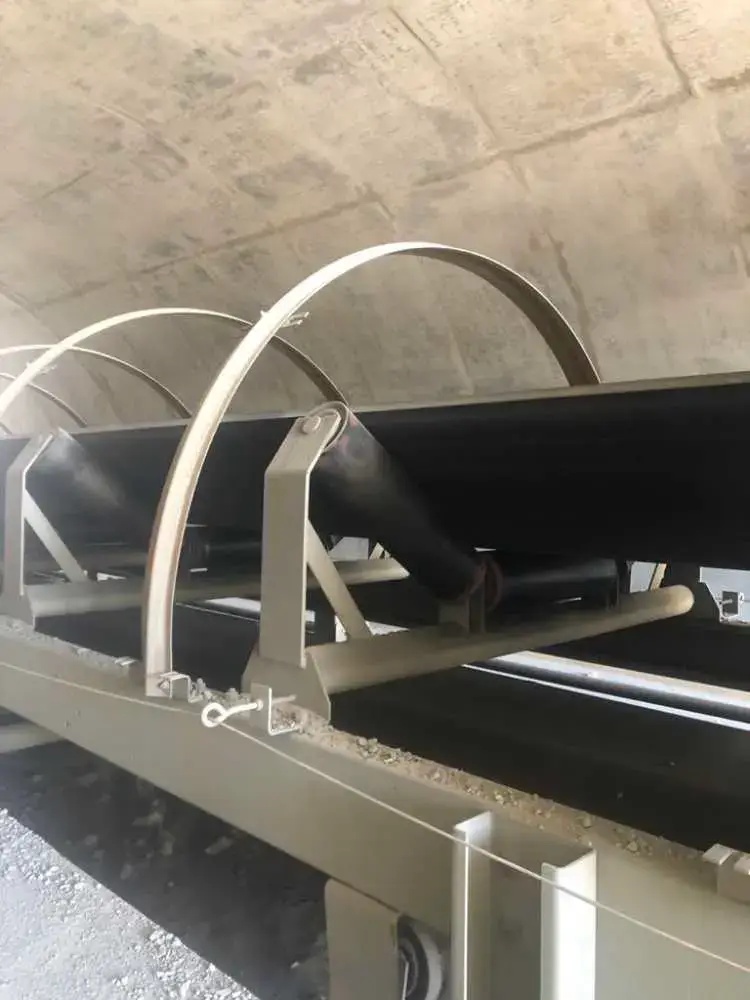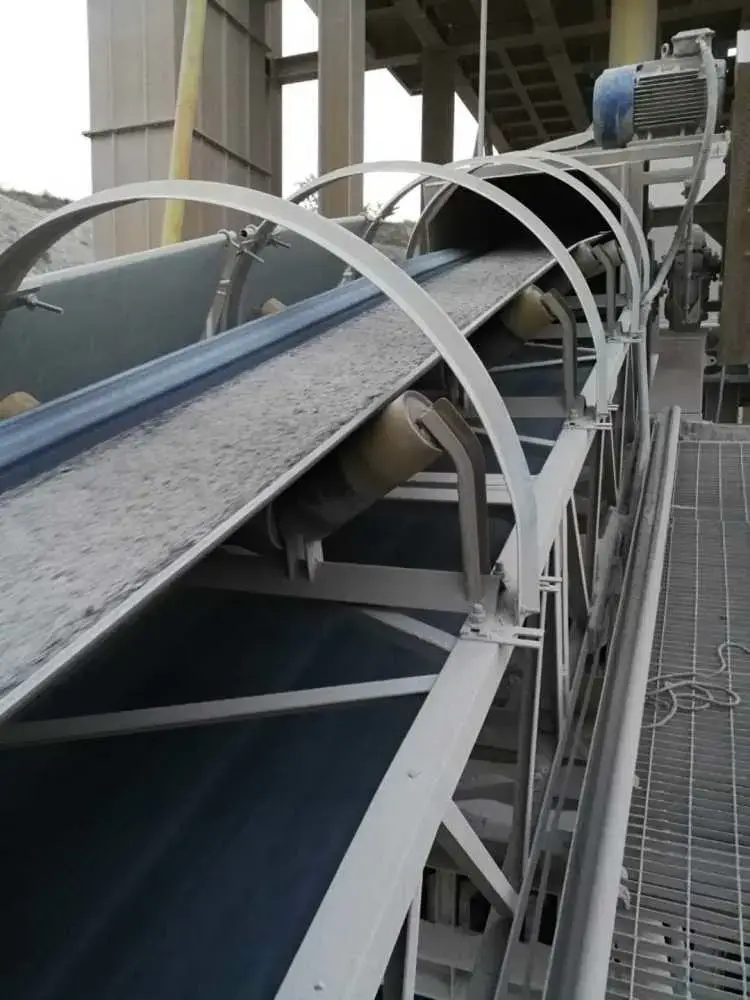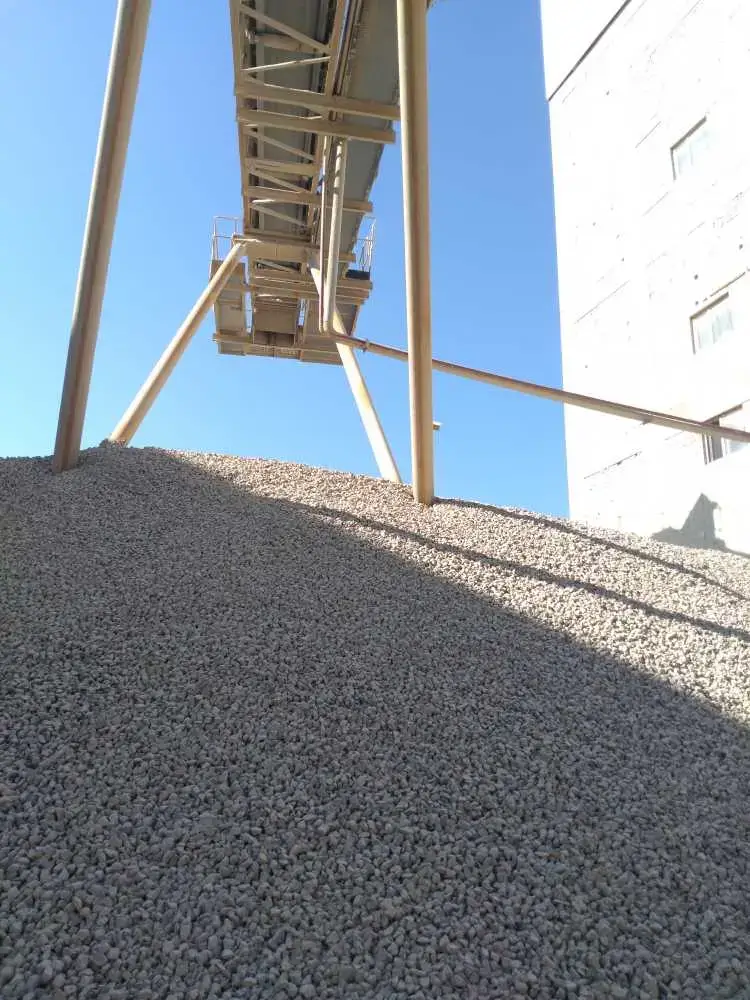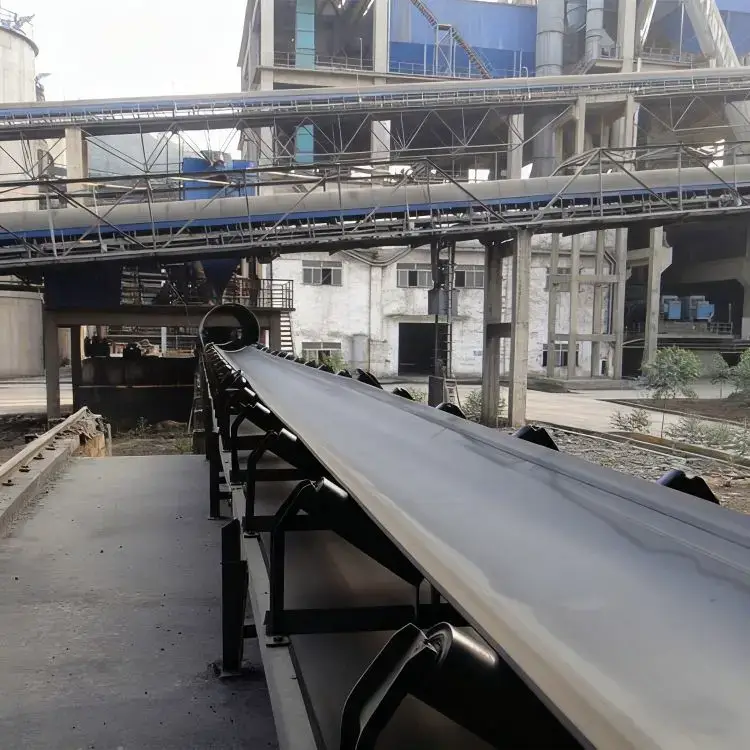Long-Distance Cement Conveying Solution
Driven by global infrastructure demand, cement enterprises continue to expand their production capacity, and long-distance bulk material conveying (typically 10-30 kilometers) from mine raw material extraction to plant production has become a critical link. However, cement enterprises worldwide generally face four core pain points that restrict production efficiency and sustainable development:
First, the imbalance between transportation efficiency and cost. Traditional reliance on dump trucks for transportation results in limited single-batch conveying capacity (only 400-600 tons per hour), and long-distance transportation costs are more than three times that of belt conveying. Based on an annual conveying volume of 6 million tons of cement raw meal, transportation costs remain high; at the same time, affected by extreme weather (heavy rain, high temperatures, heavy snow), monthly shutdown time generally reaches 3-5 days, with a production capacity loss of over 200,000 tons per month. Second, surging pressure for environmental compliance. Major global markets (EU, North America, Southeast Asia, etc.) have introduced strict dust emission standards (usually ≤10mg/m³), while open-top truck transportation and open-air stockpiling lead to dust emissions of 25-30mg/m³. This not only faces risks of tariff increases and fines but also damages the enterprise's brand image due to complaints from surrounding communities. Third, difficulties in terrain adaptation. The conveying route from the mine to the plant often needs to cross gentle slopes (12-18°) and ecological buffer zones (such as farmland and woodlands). Traditional belt conveyors require 3-5 transfer stations to achieve direction changes and slope climbing, which not only increases equipment investment by 40% but also causes a 6-8% loss rate of cement raw meal due to transfer links (re-crushing is required after agglomeration, increasing energy consumption). Fourth, lack of global operation and maintenance support. When multinational cement enterprises use equipment from international brands, they often face problems such as long spare parts supply cycles (45-60 days) and no localized technical support. In case of equipment failure, they need to wait for on-site repairs by engineers from the original factory, resulting in an annual shutdown time of over 100 hours, which seriously affects continuous production.
To address these common industry needs, ZOOMRY has launched a long-distance cement conveying solution that combines "customization + universality". It can adapt to different climate, terrain, and production capacity requirements, and has served more than 50 cement enterprises worldwide, becoming the preferred solution in the industry.
Core Requirements and Objectives of the Solution
Industry Requirements
The demand for long-distance conveying solutions among global cement enterprises focuses on four dimensions with significant commonalities: In terms of equipment parameters, multiple sets of conveying equipment are required to cover routes of 10-30 kilometers, with graded adaptation of handling capacity (trunk line ≥1800 tons per hour, branch line ≥600 tons per hour), and belt widths covering three specifications (800mm, 1200mm, 1400mm). It also needs to include three types of belt conveyors (long-distance, steep-incline, and curved) to meet the needs of different route segments; In terms of working condition adaptation, the equipment must withstand multi-climate environments (high temperature and humidity, dry heat, low-temperature cold), the gentle slope segment must adapt to an inclination of 12-18°, and the ecological buffer zone must realize 85-95° curve conveying without transfer, while avoiding occupation of sensitive areas (reducing the risk of ecological compensation); In terms of compliance standards, dust emissions ≤8mg/m³, the equipment must pass international certifications of the target market (such as EU CE, North American EPA), and the operation interface supports multiple languages (English, Spanish, Russian, etc.); In terms of operation and maintenance support, it requires a spare parts supply cycle ≤7 days, 1 year of free technical support and multilingual training, the overall service life of the equipment ≥15 years, and the service life of core components (idlers, rollers) ≥50,000 hours.
Core Objectives of the Solution
Based on common industry needs, the solution sets four universal objectives: First, efficiency upgrade – the conveying efficiency of the trunk line is stably ≥1800 tons per hour, and that of the branch line ≥600 tons per hour, with no transfer throughout the process. It completely replaces truck transportation and shortens the conveying cycle by more than 50%; Second, environmental compliance – the dust emission of the entire system is controlled within 8mg/m³, meeting environmental standards of major global markets and avoiding compliance risks; Third, cost optimization – compared with traditional truck transportation, it reduces conveying costs by ≥40%, and the initial equipment investment is 25-30% lower than that of international brands; Fourth, reliable operation and maintenance – the annual equipment failure rate ≤0.5%, the global spare parts response time ≤7 days, the independent operation rate of the customer's operation and maintenance team reaches 100%, and the annual shutdown time ≤20 hours.

Design of Long-Distance Cement Conveying Solution
ZOOMRY adopts the concept of "modular design + scenario-based adaptation" and combines the terrain, climate, and production capacity differences of global cement enterprises to create a universal solution consisting of 21 sets of core equipment + auxiliary systems + independent components. It not only ensures the unity of core technologies but also flexibly adjusts detailed parameters to adapt to different application scenarios.
Scenario-Based Selection of 21 Sets of Belt Conveyors
For the three core scenarios of long-distance cement conveying (long-distance trunk line, gentle slope segment, curved segment), the 21 sets of equipment adopt a standardized graded design, with key parameters complying with global industry standards:
- 15 sets of long-distance belt conveyors: Adapted to 10-30 km trunk lines, with a belt width of 1400mm, a handling capacity of 1800 tons per hour, and a belt speed of 3.5m/s. The core technology uses 40Cr forged rollers (diameter 159mm, tested by ultrasonic flaw detection, ovality <1.5mm) with diamond-shaped rubber coating on the surface (friction coefficient ≥0.4) to prevent cement raw meal (moisture content 8-12%, particle size 0.1-3mm) from slipping; The drive unit adopts a SEW explosion-proof gear motor (power 110kW, protection class IP55), and the heat dissipation structure can be adjusted according to the climate (adding fans for high-temperature environments, installing heating devices for low-temperature environments); The idlers use silent idlers (diameter 133mm) with radial runout ≤0.4mm, water intake ≤100g in a 72-hour immersion test, adapting to high-humidity or dry environments, and the operating noise ≤45dB, meeting community noise requirements.
- 3 sets of steep-incline belt conveyors: Adapted to 12-18° gentle slope segments, with a belt width of 1200mm and a handling capacity of 1200 tons per hour. It adopts a "deep-trough idler group (trough angle 35°) + anti-slip belt" design. Compared with ordinary belt conveyors (maximum inclination 12°), it does not require transfer stations, shortens the route length by 1.5-2 kilometers, and reduces civil engineering costs by 30-35%; The belt uses PVC integral core flame-retardant material (added with anti-aging agent) with a temperature resistance range of -10℃~50℃, adapting to major global climate zones; A non-powered dust removal chute is installed at the discharge end, combined with the sealed skirt of the belt, controlling dust emissions at 6-8mg/m³ and meeting international environmental standards.
- 3 sets of curved belt conveyors: Adapted to 85-95° curved segments (such as plant buffer zones, ecological protection zones), with a belt width of 800mm and a handling capacity of 600 tons per hour. Through "hexagonal idler group + flexible turning technology", the turning radius is only 25-30m (ordinary belt conveyors require ≥60m), avoiding occupation of sensitive areas; The idlers use HDPE material, which improves corrosion resistance by 40% and adapts to humid or dusty environments; Guide wheels are installed on both sides of the belt, controlling deviation within 5mm to prevent belt deviation in curves and reduce maintenance frequency.
Supporting Auxiliary Equipment
To realize the closed loop of "raw material receiving - conveying - stockpiling", the supporting equipment adopts a globally universal design, adapting to raw material transportation and plant layout in different regions:
- 2 sets of ZRLS-TU series wheeled truck unloaders: Used for mine raw material receiving, with a belt width of 1400mm and a handling capacity of 1000 tons per hour. Equipped with a hydraulically adjustable ramp (slope 6.7°), adapting to mainstream 25-50 ton dump trucks worldwide; The bottom of the ramp is sealed with rubber skirts to reduce dust dispersion during unloading; A vibrating feeding device is added to avoid blockage caused by agglomeration of cement raw meal, and it coordinates with long-distance belt conveyors for feeding, adapting to the intermittent unloading rhythm.
- 1 set of ZR-SF series radial telescopic stackers: Used for stockpiling in the plant raw material warehouse, with a stacking height of 18m and a storage capacity of 120,000 cubic meters (28% higher than traditional fixed stackers). It supports PLC fully automatic stacking (dual modes of "herringbone" and "circular"), reducing manual operation; It uses 4-8 super solid tires (adjusted according to site load-bearing capacity) and can move flexibly to adapt to the feeding needs of different raw material warehouses; A material level detector monitors the height in real time to avoid overload, complying with global cement plant safety standards.
Core Components
All components are independently produced by ZOOMRY, with performance exceeding international standards (ISO, CEMA), ensuring reliability and interchangeability worldwide:
- Cleaning and Sealing Components: PU cleaning scrapers (2 sets at the head, 1 set at the tail) with a fitting degree of ≥95% with the belt, removing residual raw meal to avoid agglomeration; The chute adopts a conical anti-blocking design, and the inner wall is equipped with a 12mm polymer wear-resistant coating with a service life ≥30,000 hours; Long-distance belt conveyors can be optionally equipped with canopies/dust covers, adapting to rainy or windy environments and preventing materials from being affected by weather.
- Safety Protection Components: All series of equipment are equipped with a dual safety system – belt deviation switches (automatic alarm and shutdown when deviation exceeds 5mm) and hydraulic winch self-locking devices (locking within 0.01 seconds after power failure); The stacker is equipped with an emergency stop button, complying with global industrial safety regulations and reducing accident risks.

Solution Implementation and Global Service Guarantee
With "experience, professionalism, authority, and credibility" as the core, ZOOMRY has established a unified global implementation and service system to ensure the efficient implementation of the solution in different regions:
Preliminary Survey and Customized Adjustment
For the customer's specific scenario, a team of internationally certified engineers is dispatched to conduct a survey, focusing on completing three tasks: First, obtaining route terrain data (slope, curve, sensitive area) through 3D mapping to adjust the equipment layout; Second, collecting cement raw meal samples for laboratory testing (fluidity, abrasiveness) to optimize belt speed and idler parameters; Third, docking with the compliance requirements of the customer's target market and assisting in completing international certification applications (providing a full set of technical documents) to avoid delays in customs clearance or acceptance.
Standardized Production and Logistics
The equipment is produced in ZOOMRY's standardized factories, and the entire process is integrated into the ISO 9001 system: Core components (rollers, idlers) must pass material testing and performance testing, with zero outflow of unqualified products; Logistics adopts 40HQ container modular packaging, and each box is attached with a multilingual installation manual and component list, adapting to global sea/land transportation needs; According to the customer's region, the nearest overseas warehouse is coordinated for stock preparation to shorten the delivery cycle.
Installation and Localized Training
An "modular assembly + local labor assistance" installation mode is provided, led by core engineers, and the installation cycle is controlled within 30-40 days (adjusted according to the number of equipment); During the commissioning phase, a 72-120 hour continuous full-load test run is conducted to optimize parameters until they meet the standards; A 20-day multilingual training (theory + practical operation) is provided for the customer's operation and maintenance team, covering daily inspection, fault diagnosis, and spare parts replacement. Only after passing the assessment can they take up their posts, ensuring localized operation and maintenance capabilities.
Global After-Sales and Spare Parts Support
Relying on global multi-regional spare parts warehouses (covering Asia, Africa, the Americas, and Europe), the response time for common spare parts is ≤7 days, and special components are guaranteed through expedited logistics; A 24/7 multilingual technical hotline is opened, equipped with more than 50 overseas after-sales engineers who can provide remote guidance for fault handling via video; A free comprehensive inspection is provided once a year, and equipment upgrade suggestions are given (such as PLC system optimization, component life extension transformation) to extend the equipment life cycle.
Solution Effectiveness
Dual Optimization of Efficiency and Cost
After replacing truck transportation, the conveying efficiency of the trunk line is increased to over 1800 tons per hour, the 20-kilometer conveying cycle is shortened from 4 hours to 1.2 hours, the annual material-waiting shutdown time is reduced by 30-50 hours, and the production capacity is indirectly increased by 100,000-150,000 tons; The conveying cost is reduced by more than 40% (based on an annual conveying volume of 6 million tons of cement raw meal, the cost optimization effect is significant); The transfer-free design reduces the investment in 3-5 stations, and the initial equipment cost is 25% lower than that of international brands.
Environmental Protection and Compliance Achievement
The sealed design of the entire system controls dust emissions within 6.8mg/m³, meeting global mainstream environmental standards such as EU IED and North American EPA, helping customers avoid the risks of fines and tariff increases; The loss rate of cement raw meal is reduced from 7% to 0.9% (based on an annual conveying volume of 6 million tons, the annual loss reduction is significant), and at the same time, the energy consumption of re-crushing is reduced, complying with the trend of green production.
Reliability and Operation & Maintenance Guarantee
The annual equipment failure rate is only 0.3-0.5%, the service life of core components (idlers, rollers) exceeds 50,000 hours, and the annual shutdown time is ≤15 hours; Global spare parts response and multilingual services solve the pain points of cross-border operation and maintenance. The independent operation rate of the customer's operation and maintenance team reaches 100%, and the annual operation and maintenance cost is significantly reduced, avoiding the passive situation of relying on engineers from the original factory.

Choose ZOOMRY
- Balance between Universality and Customization: It not only has standardized core modules (such as 1800 tons per hour long-distance models) but also can flexibly adjust details (such as belt material, idler type) according to climate (high/low temperature) and terrain (steep slope/curve). There is no need for design from scratch, and the adaptation cycle is 50% shorter than that of international brands.
- Global Service Network: Multi-regional spare parts warehouses and multilingual after-sales teams solve the pain points of "slow spare parts and difficult communication" of international brands, with fast response speed and 30% lower operation and maintenance costs.
- High Cost-Effectiveness: Independent production of core components + complete EPC industrial chain, the equipment cost is 25-30% lower than that of imported brands, and the quality meets international standards with a service life of more than 15 years. The investment return cycle is shortened to 2-3 years, suitable for cement enterprises of different scales (large multinational groups, regional factories).


